
The prospect of traveling to fish different waters can be intoxicating, but don’t get so caught up in the excitement that you forget to come up with backup plans to deal with eventualities like bad weather, rough seas or boat issues. Exploring new angling destinations is supposed to be fun, so your readiness to make the best of a potentially bad situation will keep you safer and reduce stress.
Detailed weather forecasts of your destination and various locations along the way should be among the key factors to consider when planning a trip.
“Always consider the possibility of things changing, and build in a little leeway to stay safe and comfortable. There is no excuse for beating up the boat or passengers,” says Capt. John Blumenthal of Palm Beach Gardens, Florida. Blumenthal has held Australian and US Coast Guard licenses since 1985, and has made 45 boat deliveries up and down the Eastern Seaboard, plus numerous shorter trips to the Bahamas.
“I look in windy.com exclusively,” Blumenthal adds. “The app provides accurate forecasts up to a week out and lets me know what systems are coming to plan accordingly. Sometimes you have to be patient and wait. Or you may have to tuck inside the Intracoastal Waterway for the trek. That will take a little longer, as you’ll have to contend with bridges and no-wake zones. But at least you’ll be in calm water.”
Blumenthal normally plans his route to reach stopovers where he has stayed previously. The familiarity with marina staff and facilities allows for early starts to minimize travel time. He’s also willing to deviate his course to take advantage of better sea conditions. For instance, one of his regular deliveries involves running a 38-foot Pursuit from Montauk, New York, to Palm Beach every fall. Normally, the trip takes five days, but one year Blumenthal had to lay up for two days to allow a front to pass.
Adjusting boat speed is another consideration. “I usually chug along at slower speeds to save fuel and extend the boat’s range,” he adds. “Then if I need to outrun an approaching weather system or stretch it to another port, I have ample fuel in reserve.”

When it comes to fishing alternatives during periods of rough seas, offshore anglers can still find great action at nearshore wrecks or inside reefs, which take the brunt of the waves. Drifting with a drift sock is another option. Aside from slowing down the boat, the drift sock helps smooth out the bumps and, if deployed accordingly, keeps the bow into the waves for added safety.
Inshore and coastal anglers should consider launching at ramps close to the fishing and sticking to the Intracoastal Waterway, or tucking behind barrier islands or other land mass with taller tree lines, places where you’ll find shelter from high winds and still enjoy productive fishing. Everglades National Park or Louisiana’s marshes, for instance, offer excellent action with a variety of species in protected bays, tidal flats and lagoons, and coastal rivers, creeks and bayous.
Blumenthal travels with at least one crewmember and carries a SPOT personal satellite locator so family and friends can track his whereabouts. A compass and paper navigation charts are among his essential travel items as well. “You need to master basic navigation skills, and be able to use a chart in case your electronics go out,” he explains.
Mike Milewski of West Palm Beach often travels to the Bahamas to fish. He leaves out of Boynton Beach Inlet aboard his 23 Regulator with a single outboard. In April and May, he targets tuna. In the summer months, he chases birds, looking for dolphin, or he deep-drops on the reefs.
“I prefer to err on the side of caution,” Milewski says. “I always have backups, especially when it comes to safety equipment, including an EPIRB. Having satellite communications is important too. I have redundant electronic switches, carry a hub kit in case we spin a prop, and a portable Garmin handheld GPS to navigate in the event of an electronics failure. I also keep an eye on the compass to make sure we stay on our desired course.”
Milewski and his crew plan trips well in advance, based on vacation days. The itinerary includes a couple of extra days to allow for weather delays. One trip, Milewski was forced to leave the boat, fly home, and then return the next weekend, when conditions for the crossing improved. He consults numerous weather apps and websites prior to departure.
“You usually know of any major changes within 48 hours, and adjust accordingly,” he says. “In the summer, with all the afternoon thunderstorms, we always get an early start so we’re across before lightning starts. Safety is paramount for me and my crew, so I’m not going to push it. There will always be better weekends ahead.”
Milewski has fished Grand Bahama, Bimini, and several other Bahamian islands. Local families in Lucaya provided ground transportation and other necessary support during previous trips. In the aftermath of devastating Hurricane Dorian, however, visiting boaters should anticipate needing extra planning, and perhaps also alternate stops.
The Bahamas Ministry of Tourism reports Freeport and the Abacos are still amid a major rebuilding process. Fourteen other Bahamas destinations, all with great fishing potential, were unaffected by the storm. For specific boating information to help you plan future trips, visit bahamasmarinas.com.









